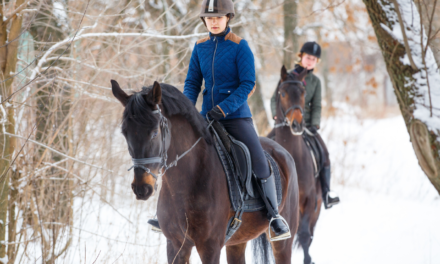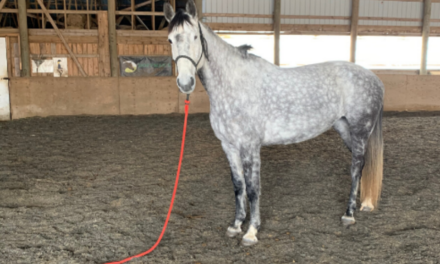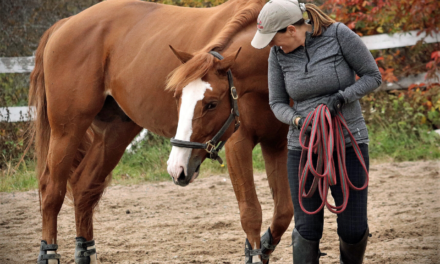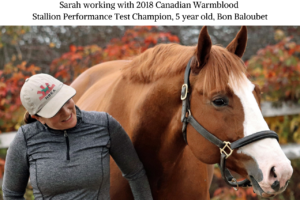We may earn money or products from the companies mentioned in this post. For more information please check out our disclosure page
What Is The Truth About Stallions?
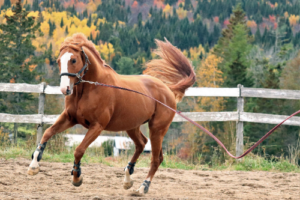
Balou playing on the lunge line
Stallions have often had a bad reputation as being bossy, domineering, hard to handle, dangerous, unpredictable, aggressive, and more. All of these things can be true, however, for many stallions most of these assumptions are completely false.
So why are some stallions considered badly behaved and some not?
The truth is it’s more about whether a stallion is well trained or not well trained and to be fair to stallions it is the same truth that applies to mares and geldings.
It is important to treat a stallion the same way as any other horse. Don’t treat him as if he is different especially as all training should be the same and equal for all horses and be centered around creating respect through groundwork and keeping your horses attention.
We need to be able to move any horse wherever we want, whenever we want using groundwork training methods that enable you to create a language between you were you ask a question of your horse and the horse immediately answers.
This training is not done by brute force but through constantly moving the horse away from gentle pressure, keeping their feet moving wherever you want to put them and constantly having the horses’ attention on you. This is how your horse learns to respect you and will follow and obey you.
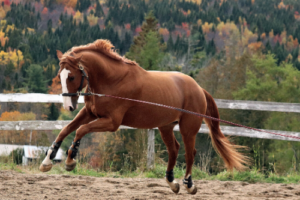
Playtime is important
A big mistake I see when people handle stallions happens when the handler fails to pay complete attention to what is going on. When I lead my stallion through the barn his attention is on me.
I am alert and aware as to where is attention MIGHT be drawn, and I keep him moving and keep his eye on me, keeping him responsive to me at all times. I do this by being a strong presence he respects, not through force, aggression, yelling or pulling.
He will walk 100 times past the same horses with me and he doesn’t pay them any attention, yet I have seen other handlers lose control when he has seen a horse he is interested in approaching.
If they lose control at this point it is because they have allowed the horse to take one step too many past the point of them having his attention and now he has control, his stallion brain kicks in and his mind is no longer with you and it is his strength against yours.
At this point you are not the leader, he will barely know you exist because in herd mentality his mind is focused on who gets the next mare.
None of this is the stallions fault. If his attention is with us in the way we have trained it to be this won’t happen.
Have your horse’s attention and he should have yours at all times when you are handling them.
Men v’s Woman as Stallion Trainers
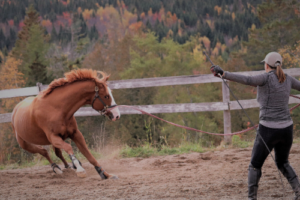
I love this photo, its a true play moment!
There is a huge myth that men can handle stallions better than women because they are stronger. This is not true at all. I am a relatively small woman and my stallion respects me at all times.
Yet my husband who is a strong man loses control of him often because he doesn’t command his respect and lets him wander through the barn on a loose rope not paying attention to where his attention is.
To be fair to my husband he is not a horse person, but he does love our stallion who in return loves him back, but love does not equate to respect and left to his own devices its only a matter of time before the stallion says OK let me just go over here.
It’s like sitting a bar of chocolate in front of me and walking away, eventually I am going to eat it because I have zero self-control when it comes to chocolate!
Be a Presence!
Most of the time I am just me around my stallion. His training has been enough for me to handle him anywhere with no problems. YET there has been the very odd occasion where he has been a moody child and on one occasion I went into his stall and he pinned his ears and swung around with his butt to me.
At this point I talked sternly to him and he hunched up as if he was going to buck out. This behaviour from him was both unacceptable to me and unexpected. By the stall entrance we keep his orange carrot stick (this is used in conjunction with a horsemanship halter and extra-long rope in his ground training).
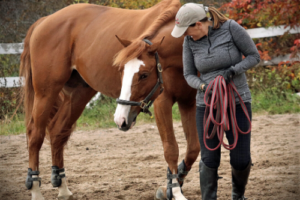
After playtime is done, he wants to connect at liberty
The carrot stick is not to hit a horse EVER. After grabbing the carrot stick I was standing in his stall doorway and I made my small frame into Ursula on crack from the Little Mermaid. I don’t know if you have seen when Ursula gets mad in the Little Mermaid movie but she grows.
That was what I did, I made my tiny frame feel like it was 20 foot tall and 20 foot wide and banged the orange stick once on the ground in front of me. He already knew he had made a mistake challenging my authority and was already in the corner with a submissive look from head to toe.
I didn’t’ fight him, I didn’t approach or attack him, I just ‘grew’ and became a presence and asserted my dominance of lead mare over his challenge just by my body language.
Respect and control are not gained by dominating or attempting to overpower a stallion physically.
If you read my other blogs you will know that body language is how the herd communicates and that the stallion is not the boss of the herd, that job belongs to the lead mare.
The Orange Carrot Stick
The orange carrot stick is a Pat Parelli training aid to use in your groundwork training. It is not meant to instill fear or hit the horse but is used to tap the ground or used like a finger or hand in order to create gentle pressure on a certain part of the horse to help you move the horses feet.
Breeding Your Stallion
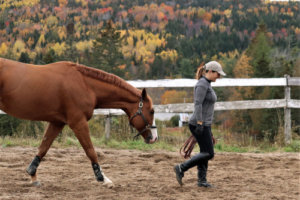
He follows me everywhere
Groundwork is a mental game that keeps the horse with you and listening to you, always maintaining its attention. If you use groundwork with your stallion and have his attention the same as you should with any horse. You will be able to handle him in any situation including when it comes to breeding,
I was vigilant in training our stallions in their groundwork from birth. When it came to breeding years later it meant that breeding manners were exactly what we needed them to be. A well-mannered stallion that stood for cleaning, walked to the phantom while the mare stood close, mounted, was collected and went back to the barn.
Additionally, it means that your stallion should have no change in how he behaves once he learns to breed and you should continue to be able to walk him past any mare and he will stay with you.
At A Show
At a show we have never had a problem with our stallion acting out, reacting to mares, or behaving like a stud, he was trained not to approach other horses when under saddle. He has never paid attention to another horse at a show. However, as with every horse but more so a stallion, you must keep their attention where it’s supposed to be at all times.
REMEMBER GOOD TRAINING AND GROUNDWORK ARE KEY TO SUCCESS WITH ALL HORSES AND A STALLION IS NO DIFFERENT.
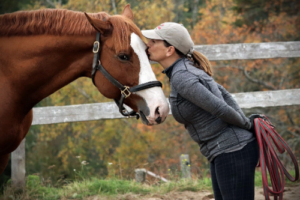
They give us such special moments
I personally find training and working with stallions a joy. The depth of the relationship is that much deeper and more rewarding than you might find with another horse. They try hard to please and they hate to fail.
At the same time they have moods where they behave like spoiled children, yet they can go to work and focus on nothing else but pleasing you.
To find out how to work on the key exercises of groundwork that will create respect between you and your horse sign up to receive my free 9 Groundwork Exercises You Will LOVE teaching your horse!
This post may contain affiliate links. Please read our disclosure for more info.
admin
Latest posts by admin (see all)
- A Horse For All Reasons – Guest Blog by Lucy from Horse Factbook - April 8, 2020
- How To Deal With A Spooky Horse Trail Riding - March 31, 2020
- Our Top 20 Amazon Equestrian Products - January 30, 2020



